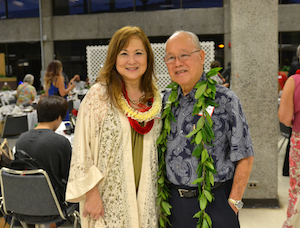
Ka Mala o Niuhelewai at Honolulu CC
By Staff Reports
(Honolulu) – It has been just three years since the start of Ka Māla o Niuhelewai (The garden of Niuhelewai) and the kalo (taro) is ready for harvest. Every April the campus celebrates the māla with the annual Ho‘olaule‘a to enjoy the harvest, food prepared in the imu, poi pounding activity, and live Hawaiian music.
3rd Annual Hoʻolauleʻa Wednesday, April 16th 10:30 am to 1:00 pm 874 Dillingham Blvd., behind the Children’s Center
“Ka Māla o Niuhelewai, has been an instrumental “hands-on” venue for students, faculty, staff, and the community is supporting the Hawaiian understanding of sustainable “mālama ‘āina” application for producing food for Hawai‘i,” shares Hawaiian Studies Instructor Mark Alapaki Luke.
Participants from diverse programs, including Hawaiian Studies, have made valuable connections via experiential learning at the māla. Activities, such as, planting with the correct moon cycles, preparation of soil, maintaining plant health, techniques to minimize pests, observing the environment of the area, irrigation techniques, harvesting of crops, and learning how to make poi boards and stones to enjoy the foods of their labor.
The māla has received the Scenic Hawai‘i Betty Crocker Landscape Award for Xeriscape in 2012, and most recently, the Honolulu Community College Sustainability Award at the 2014 Hawai‘i Sustainability in Higher Education Summit.
In keeping with the sustainability theme, reusable plates or containers, beverage cups or bottles, and utensils are encouraged to limit the usage of paper goods to alleviate excess trash in the landfill as a part of Honolulu’s sustainability efforts to care for the land.
Since 2011, 20 Hawaiian varieties of kalo have been planted. The māla has collaborated with other farmers in sharing taro and plantings, along with giving support to several K-12 schools in Hawai‘i.
Honolulu Community College received a $25,000 grant from the Office of Hawaiian Affairs to plant Hawaiian varieties of kalo in a dry land māla. The māla serves as an educational platform to teach students using a traditional Native Hawaiian holistic approach.
The historical land use of the Honolulu Community College campus is thoroughly documented in the Land Court Awards and old maps of the Kalihi-Kapālama area. The campus area alone was home to 45 documented lo‘i (taro patches), fed by Niuhelewai Stream and two springs, all of which were diverted and filled in after 1900. The idea of the project is to return a small portion to Hāloanakalaukapalili (first kalo, ancestor) to this ‘aina (land), blending the old with the new with the understanding of mālama ‘āina, or caring for the land.
ABOUT HONOLULU COMMUNITY COLLEGE For more than 90 years, Honolulu Community College has been serving the community as a comprehensive community college in the heart of Honolulu meeting the post-secondary educational needs of individuals, businesses, and the community. A member of the American Association of Community Colleges and the National Coalition of Advanced Technology Centers, Honolulu Community College has been continuously and fully accredited since 1970 by the Accrediting Commission for Community and Junior Colleges, Western Association of Schools and Colleges.




